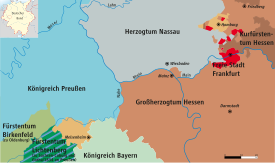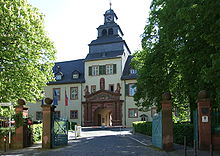Hessen-Homburg
|
||||||||||||||||||||||||||||||||||||
Hesse-Homburg was in the Holy Roman Empire a small, 1768-1806 reaching immediate Landgraviate consisting of the rule Homburg at the foot of the Taunus , who was then the height was called. The ruling princes belonged to the House of Hesse . From 1622 to 1768 it was part of Hessen-Darmstadt and from 1806 to 1815 part of the Grand Duchy of Hesse . It lived on again in 1815, expanded by the rule of Meisenheim in what is now Rhineland-Palatinate (altogether 221 km²) as a sovereign landgraviate, which existed until the princes ruling here in 1866 died out.
history
Old Kingdom (1622–1806)
The Landgraves of Hessen-Homburg were a secondary line ( secondary line) of the Hessen-Darmstadt line in the House of Hessen from 1622 to 1866 . In Hessen-Darmstadt, as in many royal courts, the primogeniture was theoretically valid . In practice, however, the younger sons were often given a part of the country. Landgrave Friedrich I of Hessen-Homburg (* 1585; † 1638), youngest son of Landgrave Georg I (* 1547; † 1609), who ruled in Hesse-Darmstadt , when the ruling Darmstadt Landgrave Ludwig V agreed with the 1622 Apanage payments were considerably in arrears. Frederick I received the town and office of Homburg vor der Höhe with all high authority and authority , but without sovereign power and was supposed to pay his allowance from Homburg's income. The Landgrave of Hesse-Darmstadt, for example, on whom the oath of service had to be taken, remained under imperial law . However, Darmstadt had undertaken to pay Homburg 15,000 guilders a year , but was mostly unable to do so. In the constitutional law of the time, the separation between sovereign power and the mere surrender of parts of the country for economic use was not (yet) clear. Hesse-Homburg's attempts to become independent began early on. In 1768, through a house contract, the so-called "settlement point", Hessen-Darmstadt was able to renounce sovereign rights over Hessen-Homburg. In this treaty, the little country received extensive internal sovereignty, but whether Hessen-Homburg became imperial immediately from then on is a matter of fact. a. Doubted by the historian Barbara Dölemeyer: “Hessen-Darmstadt only reserved the relationship to the emperor and empire; it represented Hessen-Homburg at imperial and district assemblies and raised imperial and district taxes for Homburg as well. Hesse-Homburg was therefore never directly imperial ... That is why the incorporation of Homburg into ... Hessen-Darmstadt ... from 1806-1816 cannot be described as ' mediatization ' ".
Landgrave Friedrich II , the Prince of Homburg "with the silver leg" (* 1633; † 1708), Swedish and Brandenburg general, who introduced a mercantilist economic policy and targeted development projects with his experience in the Brandenburg service should be emphasized . This included the settlement of Huguenot colonists in Friedrichsdorf . The early baroque palace in Homburg documents the economic upswing .
From 1648 to 1681 the Hessen-Bingenheim line split off.
It is noteworthy that five landgraves ( Friedrich VI. , Ludwig , Philipp , Gustav and Ferdinand ) were bearers of the Military Maria Theresa Order .
From 1806 to 1815 Hessen-Homburg was part of the Grand Duchy of Hesse .
At the end of the Old Kingdom, Hessen-Homburg consisted of the places Dillingen , Dornholzhausen , Espa , Friedrichsdorf , Gonzenheim , Homburg , Köppern , Oberstedten , Seulberg and half of Petterweil . With a contract dated April 26, 1803, an exchange of territory between Nassau-Usingen and Hessen-Homburg was agreed, in which the Nassau town of Kirdorf fell to Hessen-Homburg and the village of Espa, acquired in 1785, to Nassau.
German Confederation (1815–1866)
Landgrave Friedrich V was the only one of the princes mediated in 1806 to receive his land back in the Vienna Federal Act in 1815 . It was increased by the Oberamt Meisenheim am Glan (176 km²), part of the former French department of Sarre . Meisenheim had twice the area of the original family Homburg (85 km²); its inhabitants provided 150 men to the Homburg Jäger Battalion in the army of the German Confederation . The military was stationed in the Jäger barracks .
Until 1866, Hessen-Homburg was a sovereign state in the German Confederation , which it subsequently joined on July 7, 1817. The Landgraviate was the only German principality not to be among the founding members of the German Confederation, apart from the Duchy of Schleswig ruled by the Danish king .
In 1828 Hessen-Homburg joined the Central German Trade Association . For the Meisenheim office, the Landgraviate joined the Prussian customs system in 1830 and the German customs union in 1834 . The Homburg office was connected to the Hessian customs system and thus also to the German Customs Union in 1836.
On December 8, 1837, Hessen-Homburg joined the South German Coin Convention, concluded in Munich on August 25, 1837, and the Dresden Coin Convention, concluded on July 20, 1838, on November 20, 1838 . In accordance with these conventions, the Landgraves Ludwig and Philip had coins with a face value of ½, 1 and 2 guilders as well as 1, 3 and 6 Kreuzer minted. On January 24, 1857, Hessen-Homburg also joined the Vienna Mint Treaty. From 1858 to 1863, 38,000 Hessen-Homburg club thalers were minted. In 1849 the issue of banknotes was discussed in Hessen-Homburg, but this plan was not implemented. From 1855 the Homburger Bank existed as a central bank in Hessen-Homburg , which issued banknotes until 1876.
Contrary to the provisions of Article 13 of the Federal Act , no constitution was granted in the Landgraviate of Hessen-Homburg for a long time. Landgrave Gustav only enacted the constitution of Hesse-Homburg on January 3, 1850 as part of the March Revolution . In 1848 a state parliament of Hessen-Homburg was elected, but it should not have any significant influence. On April 20, 1852, the constitution was repealed by landgrave decree.
When Landgrave Ferdinand, the last male representative of the house, died in 1866 , the dynastic line in the male line had died out; the land fell back to Hessen-Darmstadt according to the inheritance treaty and was ceded to Prussia after the war of 1866 in the peace treaty of September 3, 1866 . Prussia incorporated the Homburg Office into the Hesse-Nassau Province and the Meisenheim Office into the Rhine Province .
With the death of Auguste Friederike in Ludwigslust on April 1, 1871 and her niece Caroline in Greiz on January 18, 1872, the Hessen-Homburg line died out.
Right to vote in the German Confederation
In the Bundestag of the German Confederation 1815–1866 the representatives of the larger German states carried virile votes . According to Art. VI, Hessen-Homburg would have received the right to vote with one full vote in the plenary, but not in the narrow council . Here, the smaller federal states and the free cities were combined in votes to form several overall votes that could only be cast as a curiate vote .
In view of the small size of the country, it would have been only natural that Hessen-Homburg would have found its place here. In complete misunderstanding of these facts, however, they demanded - with reference to the merits in the Wars of Liberation and belonging to the old Hessian princely house - a separate virile voice and a place among the major principalities. The compromise offer to be included in the virile voice of Hessen-Darmstadt (as "Hessen-Darmstadt and Hessen-Homburg") was also rejected. So they maneuvered themselves into political sideline for around 20 years. The Landgraviate only received voting rights under the government of Landgrave Ludwig . On May 17, 1838, the German Federal Assembly declared that the Landgraviate had one vote in the plenary. Now it was allowed to join the princes, who were united in the 16th overall vote, in the inner council. In the minutes of the Bundestag of September 9, 1842, Hessen-Homburg was included in the list of states of the German Confederation alongside the Russian principalities , Hohenzollern-Hechingen , Hohenzollern-Sigmaringen , Liechtenstein , Lippe-Detmold , Schaumburg-Lippe and Waldeck .
government
The government of the Landgraviate, i.e. the highest administrative authority, was organizationally divided into three departments (I. Deputation to III. Deputation) and the government chancellery. The government building was Dorotheenstrasse 22, which later became the district court of Bad Homburg vd Höhe .
A secret council was at the head of the government .
- 1817–1818: Karl Philipp August Otto Ludwig Freiherr von Zyllnhardt , Conducting Privy Council and President
- 1820–1827: Johann Philipp von Hert , Conducting Privy Council and President of all state colleges
- 1828–1832: Carl Friedrich Justus Emil (from 1830 von) Ibell , Conducting Privy Council and President of all state colleges
- 1832-1841: Vacant
- 1841–1847: Karl Bernhard von Ibell , Conducting Privy Council
- (1847–1848): Ludwig Karl Wilhelm Henrich , prov. Government director
- 1848–1862: Christian Bansa , Privy Councilor and Minister of State
- 1862–1866: Georg Fenner , Conducting Privy Council
The second man in government was the government director.
- 1818–1820: Carl Philipp Reichard , Government Director
- 1820–1827: Johann Philipp von Hert, Privy Councilor
- 1828–1834: Carl Friedrich Justus Emil (from 1830 by) Ibell, Privy Councilor
- 1835–1851, Ludwig Karl Wilhelm Henrich , Privy Councilor, later Government Director
- 1853–1861: Johann Wilhelm Zurbuch , Government Director
- 1861–1866: Ferdinand Wernigk , Government Director
Justice in the Landgraviate of Hesse-Homburg
There was no separation of justice and administration in the Landgraviate of Hessen-Homburg. The judiciary in civil matters took place in the first instance by the Justice Office Homburg or the Higher Justice Office Meisenheim. Comparable to the neighboring Duchy of Nassau , the bailiffs decided as single judges. While the previous law of the Landgraviate continued to apply in the Homburg Office, the Civil Code was applied in the Meisenheim Office .
The first deputation of the state government acted as the second instance. By decree of February 18, 1818, this had taken over the duties of the previous court court. A court of third instance did not exist in the Landgraviate (and would not have been appropriate because of its small size). Therefore, the Court of Appeal and Cassation in Darmstadt served as a third instance.
Landgrave of Hessen-Homburg 1622 to 1866
- Friedrich I. (* Darmstadt or Schloss Lichtenberg, March 5, 1585; † Homburg vor der Höhe, May 9, 1638 / ruled 1622–1638)
1638–1648 guardian government of Landgravine Margarete Elisabeth von Leiningen-Westerburg
- Wilhelm Christoph called Landgrave of Bingenheim (* Ober-Rosbach, November 13, 1625 † Hamburg , August 27, 1681 / ruled 1648–1669. Sold town and office of Homburg in 1669 for 200,000 guilders to his brother Georg Christian)
- Georg Christian (* Homburg vor der Höhe, December 10, 1626; † Frankfurt am Main, August 1, 1677 / ruled 1669–1671. Sold town and office of Homburg in 1671 to two merchants in Frankfurt; Landgrave Ludwig VI of Hesse-Darmstadt redeems the pledge - from 1673 to 1679 Hessen-Homburg remains near Darmstadt)
- Friedrich II called Prince of Homburg; General der Kavallerie (Brandenburg) (* Homburg vor der Höhe, March 30, 1633; † Homburg vor der Höhe, January 24, 1708/1679 triggers the pledged office of Homburg and ruled 1680–1708)
- Friedrich III. Jacob Governor of Tournai , Governor of Breda , General of the Cavalry (Netherlands) (* Berlin, May 19, 1673; † Hertogenbosch, June 8, 1746 / ruled 1708–1746)
- Friedrich IV. Carl Ludwig Wilhelm (* Braunfels, April 15, 1724; † Homburg vor der Höhe, February 7, 1751 / ruled 1746–1751)
1751–1766 guardian government of Landgravine Ulrike Luise zu Solms-Braunfels
- Friedrich V. Ludwig Wilhelm Christian (* Homburg vd Höhe, January 30, 1748; † Homburg vor der Höhe, January 20, 1820 / ruled 1766–1820)
1806–1815 mediated in favor of the Grand Duchy of Hesse
- Friedrich VI. Joseph Ludwig Carl August General of the Cavalry (Austria) (* Homburg vor der Höhe, July 30, 1769; † Homburg vor der Höhe, April 2, 1829 / ruled 1820–1829)
- Ludwig Wilhelm Governor of Luxembourg / General of the Infantry (Prussia) (* Homburg vor der Höhe, 29 August 1770; † Luxembourg, 19 January 1839 / ruled 1829–1839)
- Philipp August Friedrich Governor of the Federal Fortress Mainz / Field Marshal (Austria) (* Homburg vor der Höhe, March 11, 1779; † Homburg vor der Höhe, January 15, 1846 / ruled 1839–1846)
- Gustav Adolf Friedrich General of the Cavalry (Austria) (* Homburg vor der Höhe, February 17, 1781; † Homburg vor der Höhe, September 8, 1848 / ruled 1846–1848)
- Ferdinand Heinrich Friedrich General of the Cavalry (Austria) (* Homburg vor der Höhe, April 26, 1783; † Homburg vor der Höhe, March 24, 1866 / ruled 1848–1866)
More people
- Anna Margarete of Hessen-Homburg (1629–1686), Duchess of Schleswig-Holstein-Sonderburg-Wiesenburg
- Philipp von Hessen-Homburg (1676–1703), Hessen-Kassel cavalry general
- Ludwig Gruno von Hessen-Homburg (1705–1745), Russian Field Marshal General
- Elisabeth of Great Britain, Ireland and Hanover (1770–1840), the "English Landgrave"
See also
literature
- Friedrich Lotz: History of the city of Bad Homburg before the height. Volume 2, The Landgrave Period. Kramer, Frankfurt am Main 1972, ISBN 3-7829-0133-9 .
- Fried Lübbecke : Little Fatherland Homburg before the height. Kramer, Frankfurt am Main 1981, ISBN 3-7829-0254-8 .
- Herbert Rosendorfer : The Prince of Homburg. Biography. dtv, Munich 1991, ISBN 3-423-11448-7 .
- Karl Schwartz, Landgrave Friedrich V of Hessen-Homburg and his family. From archival documents and family papers, Rudolstadt 1878
Web links
- Archives about the Landgraviate of Hessen-Homburg in the Hessian Main State Archives, Wiesbaden
- Statistical and historical information on Hessen-Homburg at HGIS
- Landgraviate of Hessen-Homburg 1828 - 1st Office Homburg [western part]. Historical maps. In: Landesgeschichtliches Informationssystem Hessen (LAGIS).
- Landgraviate of Hesse-Homburg 1828 - 2nd Office Homburg [eastern part]. Historical maps. In: Landesgeschichtliches Informationssystem Hessen (LAGIS).
Individual evidence
- ↑ http://webmap.geoinform.fh-mainz.de/hgisg/multi4/startTempl.php?gliederung=2&gebiet=15&txtArea=Thema
- ↑ Archived copy ( memento of the original dated November 9, 2014 in the Internet Archive ) Info: The archive link was inserted automatically and has not yet been checked. Please check the original and archive link according to the instructions and then remove this notice.
- ^ Barbara Dölemeyer: From the Landgraviate of Hesse-Homburg to the secondary residence of the Hohenzollern. In: Bernd Heidenreich, Eckhard G. Franz (Ed.): Crowns, wars, arts. The House of Hesse in the 19th and 20th centuries. Societaetsverlag, Frankfurt 2009, ISBN 978-3-7973-1142-9 , p. 57 f.
- ^ Marc Drechsler: A paper money project for the Landgraviate of Hessen-Homburg in 1849. In: Geldgeschichtliche Nachrichten. Vol. 41, 2006, pp. 117-121.
- ↑ Knut Thomsen: The efforts of Hessen-Homburg for a seat and vote in the Bundestag. In: Communications from the Association for History and Regional Studies in Bad Homburg vor der Höhe, Volume 30 (1966) ISSN 0948-3918
- ^ Thomas Klein: Volume 11: Hessen-Nassau, the series: Walther Hubatsch: Outline of German Administrative History 1815-1945, 1979, ISBN 3-87969-126-6 , pp. 230-231
- ^ Eckhart G. Franz, Hanns Hubert Hofmann, Meinhard Schaab: Court organization in Baden-Württemberg, Bavaria and Hesse in the 19th and 20th centuries. 1989, ISBN 3-88838-224-6 , pages 208-209





